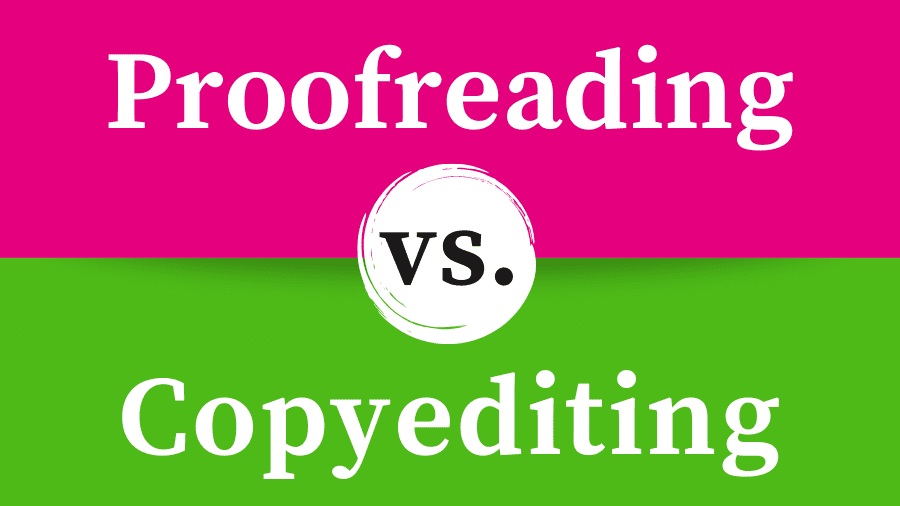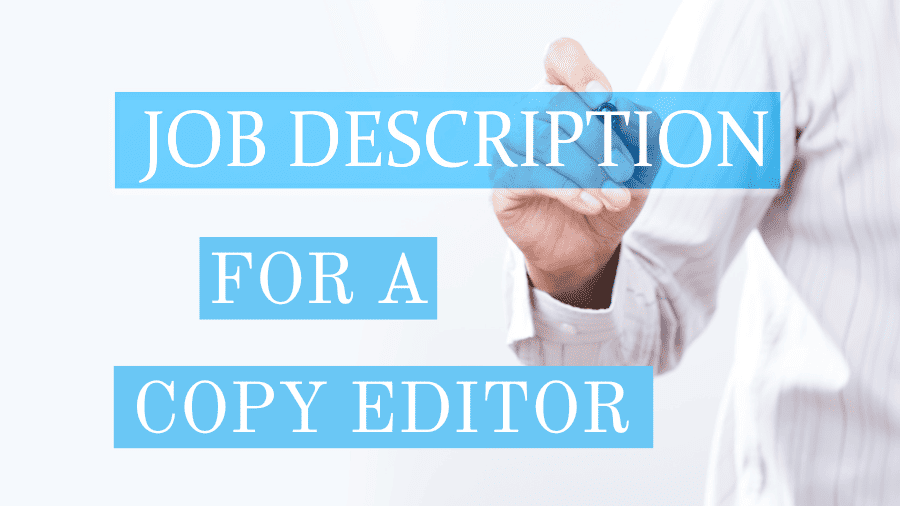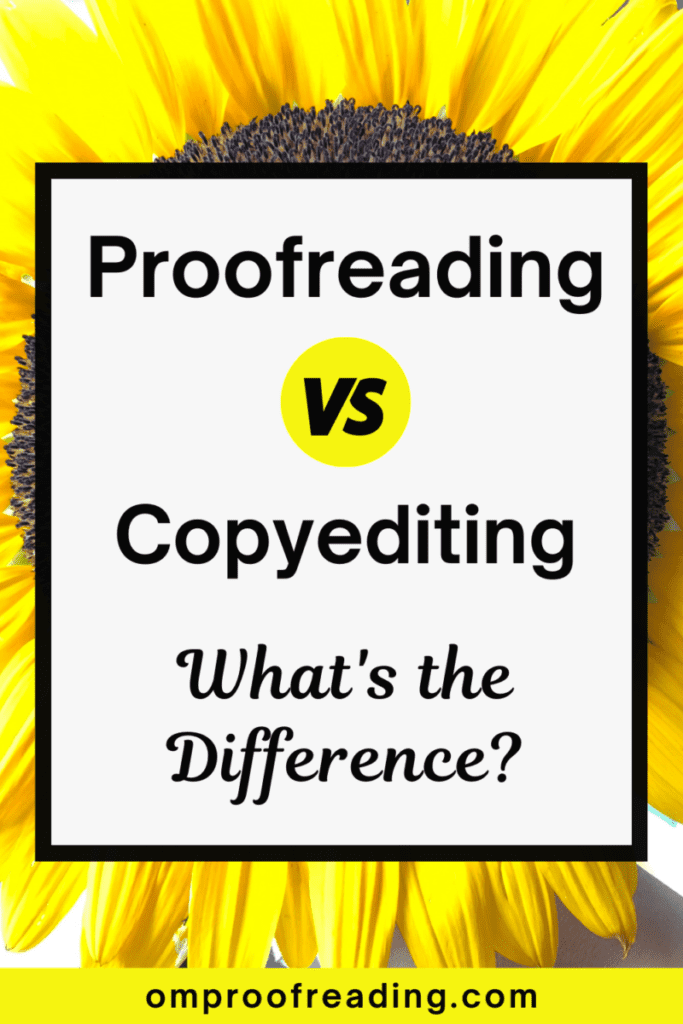This article may contain affiliate links. Please see our affiliate disclaimer in the footer menu for more information. Thank you for your support!

We often use the terms proofreading and copyediting synonymously, but they aren’t synonymous! Knowing the difference between these two words is essential if you’re considering hiring someone to polish your writing or thinking about working in the editing field.
Proofreading is the final inspection of a text to fix grammar, capitalization, punctuation, spelling, and formatting errors. Copyediting checks for the same mistakes as proofreading but also makes writing correct, comprehensive, consistent, clear, and concise.
Let’s compare the roles of the proofreader and copy editor. We’ll look at their responsibilities inside and outside of traditional publishing. We’ll also see who hires them, the kinds of texts they work on, and how much they make.
Proofreading vs. Copyediting: How Do They Differ?
Although proofreading and copyediting overlap, they differ in scope and when they’re performed.
Here’s an overview of what they encompass.
Proofreading vs. Copyediting
| Proofreading | Copyediting | |
|---|---|---|
| Scope of work | works at the word level | works at the sentence level |
| Main goal | correct errors missed during previous edits | make text clear, concise, and correct |
| When is it done? | after copyediting | after line editing/developmental editing |
| Follows a style guide? | yes | yes |
| Ensures correct dialect of English? | yes | yes |
| Makes writing more clear and concise? | no | yes |
| Fixes awkward wording and transitions? | no | yes |
| Includes fact-checking? | no | sometimes |
| Alerts author to libel and plagiarism? | no | sometimes |
This article will focus on proofreading and copyediting outside of the publishing industry since that’s what you typically encounter nowadays when you hire a freelancer or online proofreading and editing service.
Now, proofreaders collaborate directly with authors and mark up documents on-screen using Track Changes in Microsoft Word or the Suggesting feature in Google Docs.
However, since traditional publishing is where it all started, let’s briefly review the roles of proofreaders and copy editors.
Traditional Proofreading and Copyediting
In traditional proofreading (in the publishing industry), the copy editor—not the proofreader—is responsible for fixing grammar, capitalization, punctuation, and spelling errors.
At a publishing company, copyediting is the step before typesetting.
After the text has been typeset, a proofreader checks the typeset copy (known as a proof) for mistakes.
Since they read the proof, they’re known as proofreaders. 😊
Nowadays, most of the pre-publication work is done digitally using Adobe Acrobat or some other PDF markup tool.
However, in some publishing houses, proofreaders still work with a printed version of the typeset document. They use proofreader’s marks while working on these hard copies.
They flag typos and other errors that the copy editor missed and look for formatting issues like bad word breaks, improper font size or style, and out-of-order page numbers.
Here’s a short video by Editors Canada that discusses the role of a proofreader in the publishing industry.
Now let’s tune back in to modern proofreading and copyediting.
What Is Proofreading?
Proofreading comes after copyediting. It’s the final step in the editorial process, which includes the following four stages:
- Developmental editing
- Line editing
- Copyediting
- Proofreading
A proofreader is the last person to see a document before it reaches readers.
Therefore, the proofreader will try to rectify any remaining errors in the writing.
Proofreading is meant to be done on a reasonably clean document—meaning that relatively few mistakes should remain in the text when a proofreader works on it.
I wrote an article discussing the differences between developmental editing and proofreading if you’d like to know more.
What Does a Proofreader Do?
A proofreader does the following:
- fixes errors with grammar, capitalization, punctuation, spelling, and formatting
- checks for omitted and repeated words
- looks out for improper word choices (e.g., principle vs. principal)
- flags any egregious errors
- verifies that captions match any visual elements (e.g., graphs, charts)
- checks that reference lists, works-cited pages, and bibliographies are correctly formatted
- ensures the right dialect of English (US, UK, Canadian, or Australian) is used consistently throughout the text
- follows the appropriate style guide to ensure anything they correct (punctuation, usage, etc.) aligns with the guide
For example, how much space a proofreader leaves on either side of an em dash (—) can vary depending on the style guide.
The Chicago Manual of Style calls for no space on either side of the em dash; however, The Associated Press Stylebook says to leave one space on either side.
A Note about Proofreading Long Works
Proofreaders who work with longer texts like book manuscripts will have additional components to proof. They could include any of the following:
- acknowledgments
- introductions
- tables of contents
- glossaries
- bibliographies
- indexes
- chapter headings
The proofreader will also make sure these ancillary elements are in the proper order, and they’ll check cross-references.
A cross-reference is a specific point in a text that directs the reader to relevant information elsewhere within the same document.
If you want to become a proofreader, I wrote an article about the best online proofreading courses available.
What Is Copyediting?
Copyediting is the penultimate step in the editorial process. Although the responsibilities of a copy editor overlap with those of a proofreader, copyediting encompasses a broader scope.
Copy editors are responsible for making written work easier to read; however, they always aim to preserve the writer’s voice. And this is crucial!
What Does a Copy Editor Do?

A copy editor does the following:
- makes writing clear, concise, correct, comprehensive, and consistent (known as the five c’s of copyediting)
- fixes mistakes with grammar, capitalization, punctuation, spelling, and formatting
- points out omitted or repeated words and improper word usage
- flags or fixes any obvious oversights (like if the author contradicts themself)
- ensures tables, graphs, and other illustrations contain the correct captions
- checks that reference lists, works-cited pages, and bibliographies are properly formatted
- makes sure the proper English dialect is used consistently
- verifies the writing conforms to the rules in the relevant style guide
- alerts the author to potential legal issues like libel and plagiarism
Finally, some copy editors offer fact-checking, while others do not (be prepared to pay more for this service).
The Three Levels of Copyediting
Copyediting has three levels: light, medium, and heavy.
As you may have guessed, light copyediting means the copy editor will use a lighter hand while making edits. They won’t intervene in the text as much as they would for medium copyediting.
For example, light copyediting may mean the copy editor flags ambiguous or wordy sentences and perhaps offers suggestions for improving them.
However, with heavy copyediting, they may fix poorly worded sentences instead of merely alerting the author that they exist.
Freelancers and editing services vary in what they provide, so it’s essential to know precisely what you’re getting if you plan to hire someone to polish your prose.
A Note about Copyediting Long Works
A copy editor who takes on lengthy documents will have more responsibilities. For example, when working with a fiction book, they’ll also do the following:

- ensure character and setting descriptions stay consistent
- look for mistakes in the continuity of the timeline
- make sure all elements of the manuscript (e.g., index, chapter headings, page numbers) are in the correct order and check cross-references
People Who Hire Proofreaders and Copy Editors
Any organization or individual who produces copy (written content) that others will read can hire proofreaders and copy editors.
Some examples of those who hire proofreaders and copy editors include the following:
- business owners
- entrepreneurs
- publishing companies
- public relations firms
- marketing agencies
- bloggers
- job seekers
- undergrad and grad students
- transcriptionists
- scriptwriters
- self-publishing authors
The Kinds of Texts Proofreaders and Copy Editors Work On
Proofreaders and copy editors work on a wide variety of documents. Here are some examples:
- website copy
- newspaper and magazine articles
- theses
- dissertations
- essays
- academic journals
- business reports
- user manuals
- product descriptions
- transcripts
- books and e-books
- flyers and brochures
- résumés and cover letters
- screenplays
- press releases
- emails
How Much Proofreaders and Copy Editors Get Paid
Let’s see how much copy editors and proofreaders typically make. Of course, earnings will depend on someone’s training, expertise, and experience.
The salaries below are for those working in the United States.
All data is from 2025 except the data from the Bureau of Labor and Statistics (BLS), which is from May 2023.
Average Salaries of Proofreaders and Copy Editors
| Proofreaders | Copy Editors | |
|---|---|---|
| BLS | $51,100 | Not Given |
| Payscale | $50,694 | $56,054 |
| SalaryExpert | $46,966 | $69,844 |
| Zippia | $49,392 | $62,599 |
| ZipRecruiter | $57,520 | $59,809 |
Frequently Asked Questions
What is the difference between copyediting and editing?
Copyediting involves correcting errors in a document and making it reader-friendly by performing sentence-level edits. Editing entails a much broader scope as it focuses on the piece of writing as a whole and seeks to improve its content and structure.
What is the difference between copywriting and proofreading?
Copywriting is the process of creating written content that persuades people to take action, such as purchasing a good or service. Proofreading is the process of finding and fixing errors in the final draft of a piece of writing.
If you’d like a more detailed answer to this second question, I wrote an article that thoroughly discusses the differences between proofreading and copywriting.
I hope this post has helped you to differentiate between proofreading and copyediting.
If you’d like to read a similar article, you may enjoy my post “Copyediting vs. Copywriting: What’s the Difference?”
If you have a piece of writing that needs attention, I authored an article about the speediest proofreading and editing companies on the market.
Best wishes to you!
“When things do not go your way, remember that every challenge—every adversity—contains within it the seeds of opportunity and growth.”
– Roy T. Bennett

Recent Posts
Punctuation is important because it enables us to communicate our message clearly and effectively. Without punctuation, we wouldn’t understand how units of a sentence relate to one another or how...
Although you're probably somewhat familiar with adverbs, you may be unaware of sentence adverbs. As a trained proofreader who has studied the parts of speech, I can help you understand this unique...
